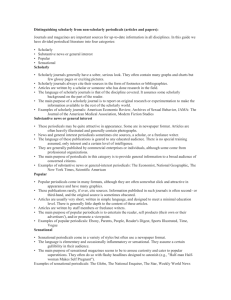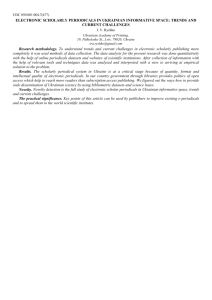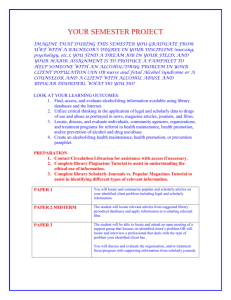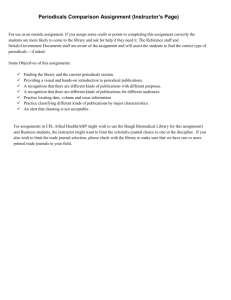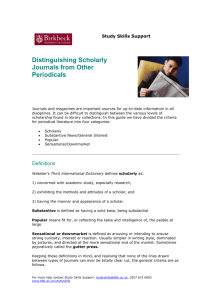MS Word Format
advertisement
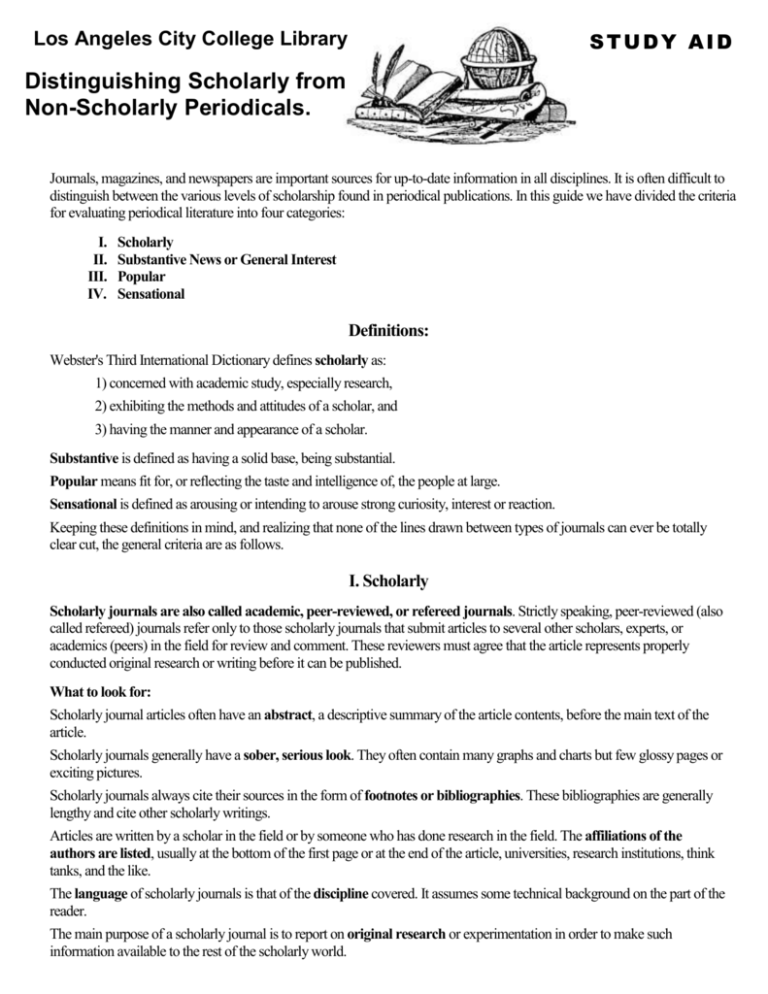
STUDY AID Los Angeles City College Library Distinguishing Scholarly from Non-Scholarly Periodicals. Journals, magazines, and newspapers are important sources for up-to-date information in all disciplines. It is often difficult to distinguish between the various levels of scholarship found in periodical publications. In this guide we have divided the criteria for evaluating periodical literature into four categories: I. II. III. IV. Scholarly Substantive News or General Interest Popular Sensational Definitions: Webster's Third International Dictionary defines scholarly as: 1) concerned with academic study, especially research, 2) exhibiting the methods and attitudes of a scholar, and 3) having the manner and appearance of a scholar. Substantive is defined as having a solid base, being substantial. Popular means fit for, or reflecting the taste and intelligence of, the people at large. Sensational is defined as arousing or intending to arouse strong curiosity, interest or reaction. Keeping these definitions in mind, and realizing that none of the lines drawn between types of journals can ever be totally clear cut, the general criteria are as follows. I. Scholarly Scholarly journals are also called academic, peer-reviewed, or refereed journals. Strictly speaking, peer-reviewed (also called refereed) journals refer only to those scholarly journals that submit articles to several other scholars, experts, or academics (peers) in the field for review and comment. These reviewers must agree that the article represents properly conducted original research or writing before it can be published. What to look for: Scholarly journal articles often have an abstract, a descriptive summary of the article contents, before the main text of the article. Scholarly journals generally have a sober, serious look. They often contain many graphs and charts but few glossy pages or exciting pictures. Scholarly journals always cite their sources in the form of footnotes or bibliographies. These bibliographies are generally lengthy and cite other scholarly writings. Articles are written by a scholar in the field or by someone who has done research in the field. The affiliations of the authors are listed, usually at the bottom of the first page or at the end of the article, universities, research institutions, think tanks, and the like. The language of scholarly journals is that of the discipline covered. It assumes some technical background on the part of the reader. The main purpose of a scholarly journal is to report on original research or experimentation in order to make such information available to the rest of the scholarly world. Adapted with permission from Olin Library Reference, Research & Learning Services, Cornell University Library, Ithaca, NY, USA. Many scholarly journals, though by no means all, are published by a specific professional organization. Examples of scholarly journals: American Economic Review. Applied Geography. Archives of Sexual Behavior. JAMA: The Journal of the American Medical Association. Journal of Marriage and the Family (published by the National Council on Family Relations). Journal of Theoretical Biology. Modern Fiction Studies. II. Substantive News or General Interest These periodicals may be quite attractive in appearance, although some are in newspaper format. Articles are often heavily illustrated, generally with photographs. What to look for: News and general interest periodicals sometimes cite sources, though more often do not. Articles may be written by a member of the editorial staff, a scholar or a free lance writer. The language of these publications is geared to any educated audience. There is no specialty assumed, only interest and a certain level of intelligence. They are generally published by commercial enterprises or individuals, although some emanate from specific professional organizations. The main purpose of periodicals in this category is to provide information, in a general manner, to a broad audience of concerned citizens. Examples of substantive news or general interest periodicals: The Economist. National Geographic. The New York Times. Scientific American. Vital Speeches of the Day. III. Popular Popular periodicals come in many formats, although often slick and attractive in appearance with lots of color graphics (photographs, drawings, etc.). These publications do not cite sources in a bibliography. Information published in popular periodicals is often second or third hand and the original source is rarely mentioned. Articles are usually very short and written in simple language. The main purpose of popular periodicals is to entertain the reader, to sell products (their own or their advertisers), or to promote a viewpoint. Examples of popular periodicals: Ebony. Parents. People Weekly. Readers Digest. Sports Illustrated. Vogue. IV. Sensational Sensational periodicals use elementary and occasionally inflammatory or sensational language. The main purpose of sensational magazines seems to be to arouse curiosity and to cater to popular superstitions. They often do so with flashy headlines designed to astonish (e.g., Half-man Half-woman Makes Self Pregnant). Examples of Sensational periodicals: Globe. National Examiner. Star. Adapted with permission from Olin Library Reference, Research & Learning Services, Cornell University Library, Ithaca, NY, USA.
